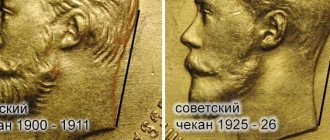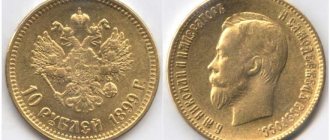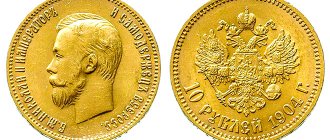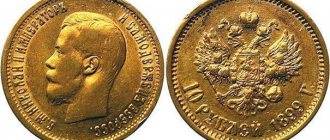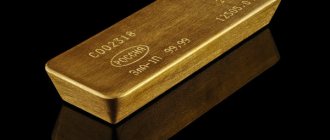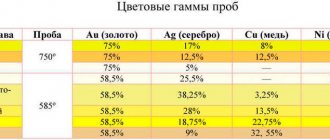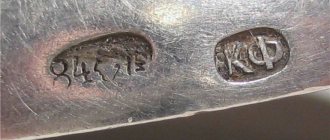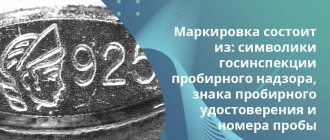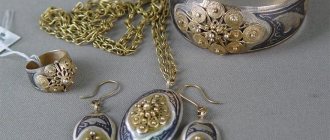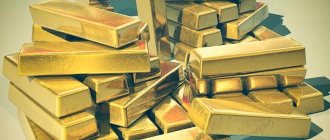Greetings to all long-time and new fans of our articles from the numismatic series. The history of our state goes back many centuries; we received many valuable artifacts in memory of its greatness. Among antiquities, royal gold coins of the Russian Empire occupy a special place.
Today, the price offered for the royal gold chervonets can vary from tens of thousands to tens of millions. In this article I will talk about gold banknotes, starting from the money of the times of Peter I and ending with the Nicholas chervonets. In addition, the article: history of origin, varieties, investment attractiveness, as well as the pros and cons of such investments.
Types of golden chervonets of tsarist times
In 1701, Peter I resumed the production of gold coins as banknotes. They were intended primarily for foreign trade.
The tradition of issuing royal gold chervonets was subsequently adhered to by all Russian monarchs without exception. However, Russia began to mine its own gold only closer to the second half of the 18th century, so until the Witte reform in 1895, silver was the basis for commodity-money payments. And royal gold coins were minted in small quantities.
Traditionally, the royal profile was located on the obverse of the chervonets, and the state emblem was located on the reverse.
Designation of the degree of rarity of coins according to the Bitkin catalog:
- R – quite rare, 50-100 pieces;
- R1 – rare, 20-49 pieces;
- R2 – very rare, 10-19 pieces;
- R3 – very rare, 4-9 pieces;
- R4 – the rarest, 2-3 pieces;
- Un is unique, the only copy.
Peter I
Starting from 1701, gold money was issued almost annually in relatively small editions from several thousand to several tens of thousands of pieces. Tsar Peter's coins were minted in denominations of 1 chervonets and 2 chervonets until 1716 from precious metal of 969-980 standard. In terms of weight, they were brought into line with the European ducat then in use.
The issue was carried out at the Red and Kadash mints. The weight of the samples is 3.47 and 6.94 g, respectively, their diameter is 23-24 mm. Since 1718, the royal gold chervonets have been known as 2 rubles, made of 781 standard metal weighing 4.1 grams.
All copies from the time of Peter I are classified as very rare, their price skyrockets.
They were made using artisanal methods; there are a great many varieties of coins, even within the same circulation. Designation according to Bitkin’s catalog – R1-Un. Price from 50 thousand to 9 million.
Peter II
Under Peter II, from 1718 to 1728, low-grade two-ruble coins were minted. And only in 1729 were full-fledged royal chervonets issued with a circulation of 17 thousand pieces. The gold ones were of 981st standard. The mass of the object is 3.47 g, the diameter is 2 cm. Twice more, in 1727-28, gold coins of two-ruble denomination were minted with a circulation of 9,397 copies, 781-carat gold. Weight – 4.1 g, diameter – 2 cm. Designation according to Bitkin’s catalog: R1, R3. Price from 0.5 to 6.8 million.
Anna Ioannovna
Under Empress Anna Ioannovna, gold chervonets were minted from 968-carat metal. Three circulations are known - in 1730 (8764 pieces), 1738 (4002 pieces) and 1739 (65,953 pieces) at the Kadashevsky and St. Petersburg courtyards. The coins weigh 3.47 grams, diameter – 2 cm. Bitkin: R2, R4.
Price 0.28–1.3 million in national currency.
Elizaveta Petrovna
Under Elizabeth, royal gold coins worth 1 chervonets were minted from 1742 to 1757 from 968-carat gold, weighing 3.47 grams, with a diameter of 20-23 mm. Circulations ranged from 489 to 18,794 pieces. Bitkin: R2-R4. In 1749 and 1751, commemorative double chervonets were also issued with a circulation of 600 and 3360 copies, respectively. Designation according to Bitkin’s catalog – R1-R3.
The production of royal ruble coins began in 1755, denominations: half, 1, 2, 5 half-imperials and 10 imperials from 917-carat alloy. Gold coins were issued by the St. Petersburg and Moscow mints. They weighed at the rate of 1 ruble. – 1.6 grams. Circulation ranges from 5-50 thousand copies, the larger the denomination, the smaller the circulation of the issue. Bitkin: R-R3.
The price of royal coins of the Elizabethan era ranges from 30 thousand to 12.75 million.
Peter III
During the reign of Peter III, the issue of royal gold money was made only once - in 1762. Money was minted in denominations of 5, 10 rubles and chervonets. Gold alloy samples – 917 and 978 for chervonets. Circulations: 9482, 25,876 and 10,042 pieces respectively. The weight of chervonets was 3.47 grams, ruble denominations were 8.28 and 16.57 g. Mints - Moscow and St. Petersburg. Designation according to Bitkin's catalog: R1-R2. The price of copies now ranges from 1 to 3.5 million.
Catherine II
During the reign of Catherine II, in 1762, the weight of the royal five- and ten-ruble coins was forced to be reduced in order to bring them into line with silver banknotes in terms of metal value. At that time, the price of gold relative to silver was 1:15. Gold ones became lighter by about 20%. Their weight was 6.54 and 13.09 grams. The fineness of the metal alloy is 917.
In total, during the years of Catherine’s reign, 1,075,753 ten-ruble imperials and 927,378 five-ruble half-imperials were made. Production took place at the Moscow and St. Petersburg courtyards. Designation according to Bitkin: R-R3.
Expert opinion
Alexander Ivanovich
Private collector with 4500+ coins and bonds in his personal collection. Knows the value of each of them today.
The minting of royal chervonets was significantly reduced due to their unprofitability. In 1763, 50 thousand copies of them were produced, in 1766 - 28,334 pieces. and in 1796 – 39,981 pieces. made of 978 gold. All chervonets were issued by the St. Petersburg Mint, Bitkin: R-R1.
Paul I
Having ascended the throne, Paul I began to change the appearance of money. According to historians, the emperor was embarrassed by his appearance, so the motto of the knightly order of the Templars was placed on the obverse instead of the royal profile. The reverse became the obverse, but the traditional eagle was soon replaced. Instead, they began to mint an ornament in the form of four “Ps”.
The composition of gold has also changed - for the production of royal 5 and 10 rubles. We used a purer gold alloy, 986 standard. In total, from 1796 to 1801, the following were issued: half-imperials - 510,880, weighing 6.08 grams, and chervonets - 162,220, weight in grams - 3.49. The issue was carried out by the Bank and St. Petersburg mints. Bitkin R-R4, price reaches 5 million.
Alexandra I
Under Alexander I, royal imperials and semi-imperials were minted in the periods from 1802 to 1806 and from 1817 to 1831. The design has undergone changes again. The obverse was decorated with 4 shields, on the reverse there is the inscription “state Russian coin”. Later, in 1817, the shields were replaced with a new coat of arms - an eagle with lowered wings. Gold 917 standard, weight - 6.54 and 12.17 g. The total circulation was: 5 rubles. – 4,555,283 pcs., 10 rub. – 201,462 pcs. Bitkin R-R4, price from 20 thousand to 5 million.
Alexandra III
Alexander III was crowned in 1881. He revived the minting of the obverse and reverse of the royal gold in the traditional design, with a profile and coat of arms. From 1881 to 1886 inclusive, banknotes in denominations of 3 and 5 rubles were minted. made of 917 standard metal. Since 1987, instead of the three-ruble coin, the issue of the imperial began, but the gold standard of the remaining two denominations was reduced to 900.
During the 13 years of the sovereign's reign, the following were minted: 3 rubles. weighing 3.93 g - 124,037 pcs., 5 rubles. weighing 6.45 g – 31 019 115 pcs., 10 r. weighing 12.9 g - 1,424,654 copies. Depending on individual characteristics and the degree of preservation, the price for them ranges from 16 thousand to 4.3 million. Designation according to the Bitkin catalog: from standard (not rare) to R4.
Nicholas II
The reign of Emperor Nicholas II was marked by the transfer of the monetary system to the gold standard and the appearance of several new denominations of chervonets: 7.5 and 15 rubles, as well as the largest coins in the entire history of tsarist Russia - 2.5 imperial and 37.5 rubles, or 100 francs True, these denominations were classified as donative (gift) signs. Very few of them were minted - 476 and 235 copies. The price for such items is 3–18 million rubles.
Gold purity – 900, manufacturer – St. Petersburg Mint. Over the entire period of his reign, the issue of gold chervonets amounted to: 5 rubles - more than 112 million pieces (more accurate information is not available due to the loss of data for 1909), 7.5 rubles. – 16,829,000 pieces, 15 rubles – 11,900,033 pieces. The price ranges from 3 thousand to 5.8 million for individual copies.
Appearance
The first mentions date back to the reign of Ivan the Terrible. Then the word “chervonets” began to displace “Ugric”. Since ancient times, this was the name given to the golden European ducats that came from Hungary. Although it was not necessarily the coinage of a given country. They were mainly used to pay for the labor of foreign mercenaries. What is a chervonets from an entomological point of view? This refers to a coin made of “red gold.” But we are not talking about the color of the metal, but about its quality. In other words, this is what high-grade coins were called.
The modern, more popular analogue is red (square, maiden, corner). From the jewelry itself, we should remember the minting of gold kopecks, which took place before the Time of Troubles. But the real royal chervonets appears during the time of Peter I. Then a major monetary reform was carried out. As a result, the appearance of the coins completely changed. In addition, the basis is not a penny, as it was before, but a silver ruble coin. It was then that the first real chervonets (including double ones) appeared. They were gold coins that had no face value. Their weight and fineness corresponded to Dutch ducats. The difference was the presence of a portrait of Peter I.
The rarest and most expensive gold ten-ruble notes from the period of Tsarist Russia
The older the banknote, the fewer copies have survived to this day, especially in good condition. The price of such chervonets is significantly higher than the average. Let me give you a few examples:
- Tsar's chervonets of Peter I, 1712, state of preservation of the three-hundred-year-old gold coin - XF, price - 9 million rubles.
- 10 rubles 1757, Empress Elizaveta Petrovna, portrait by Dacier, safety XF, price - 12,746,457 Russian rubles.
- Emperor Alexander III, imperial 1887, sale price – 4,165,195, Proof preservation.
- The famous Nikolaev 10 rubles, produced in 1906, price – 5,803,120 rubles.
Story
The gold ten of 1901 issue appeared thanks to the monetary reforms of Yu. Witte. In order to improve the economic situation of the state, the Minister of Finance introduced the backing of the ruble in gold.
Without detracting from the dignity of the coin, it should still be said that this is just a two-centimeter gold circle. In pre-revolutionary Russia, it was a common banknote for payments between buyers. It was freely exchanged for paper money and vice versa. Historians claim that the Russians were not very fond of them because of their small size and the inconvenience associated with them. Ask yourself which is easier to lose: a small gold round or a large paper bill, and the answer will become obvious.
But hiding treasures with “royal chervonets” was very convenient. This is probably the reason for the numerous stories and legends about treasures, inherited wealth and criminal crimes associated with this coin.
The gold tenth originally weighed 12.9 grams and was pegged to silver. With the appearance in circulation of the gold chervonets of Nicholas II of 1901, 10 rubles were equated to pure gold weighing 7.8 grams (rounded).
Is it worth investing in gold coins?
Investments in rare banknotes are certainly reliable. You invest in both gold and antiques. Such a gold coin can be sold at least at the current price of the precious metal. But everyone decides the question of benefit for themselves, since this method has its own nuances.
Advantages and disadvantages
Pros:
- Low risk of capital loss.
- The price of rare chervonets from Tsarist Russia is constantly growing.
- In itself, the passion for rarities is a prestigious hobby.
There are also disadvantages. I include among them:
- Low liquidity. Selling at a good price quickly will most likely not work.
- Storage costs (secured premises, safe deposit box).
- Long-term investment. To get a tangible income, you either need to wait 20-50 years, or get incredible luck in the person of a fabulously generous client.
- High entry price when it comes to rare specimens.
Price
The cost of a 10 ruble gold coin from 1901 largely depends on a number of factors. Some have a slight effect, others can significantly reduce or increase the price tag:
- Instance state. This factor is given primary attention. For example, a poorly preserved specimen (G) will be much cheaper than a chervonets in excellent condition (MS);
- Place of purchase. The cost at auction or from the hands of an intermediary are often completely different things. If at auction the price depends on demand, then the intermediary strives to earn as much as possible from the service;
- Delivery method, terms of purchase. These details are discussed individually by the parties to the transaction, based on the results of which the final price is determined;
- Time to buy. The price of coins increases over the years, and if it is also spurred by active demand, then the cost can increase significantly. The quotation of precious metals also plays an important role.
Below is a table of the average cost of the coin “10 rubles 1901 AR or FZ” at auctions.
| Coin | Price in rubles |
| Federal Law | 40000 |
| AR | 80000 |
| Soviet coinage | 80000 |
A study of auctions shows that the starting price can sometimes start at 1000 rubles, but the bids for the lot end up being at the level of the average price from the table. We should not forget that value is a conditional thing, therefore the final price for a coin is set directly by the seller and buyer, with mandatory confirmation of the authenticity of the sample if the transaction takes place outside of the auction.
Where can you buy or sell
Leadership in matters of trading rare royal chervonets at auction houses. By organizing online bidding, the auction attracts many potential interested parties without territorial reference.
In addition, auction houses guarantee the reliability of the transaction to the seller and the authenticity of the goods to the buyer when they take on the functions of an intermediary. This is especially true for beginners and investors who hardly know what real gold from the 17th–19th centuries looks like and what differences there are between fake chervonets.
There are a great many similar auction houses and galleries. Among domestic traders, the following are famous: Alexander, Tsar's coins, Volmar, Russian Heritage. From foreign auctions: Künker, Numismatica Genevensis, Gorny & Mosch, Stack's Bowers & Ponterio.
Prices for royal gold chervonets today
To complete the picture, I am posting here a table with current prices for royal gold coins. The report on how much banknotes are worth is compiled based on transactions carried out over the past few years.
| Year of minting of the chervonets | G | VG | F | VF | XF | AU | UNC | Proof |
| 1797 SM-GL | — | — | — | 507 509 | 262 657 | 1.01 million | — | — |
| 1796 BM | — | — | — | 3.40 million | 2.00 million | — | — | — |
| 1796 SPB without initials | — | — | — | 396 777 | 525 000 | 896 589 | — | — |
| 1796 SPB-TI | — | — | — | — | 579 469 | — | — | — |
| 1796 SPB-TI remake | — | — | — | — | — | — | 2.50 million | — |
| 1766 SPB-TI | — | — | — | — | 1.37 million | — | — | — |
| 1763 St. Petersburg | — | — | — | 367 432 | 625 000 | — | — | — |
| 1762 St. Petersburg | — | — | — | 3.58 million | — | — | — | — |
| 1757 SPB-Y | — | — | — | 553 183 | 870 115 | — | — | — |
| 1753 | — | — | — | — | 1.39 million | 1.86 million | — | — |
| 1751 | — | — | — | 1.52 million | 2.02 million | 1.09 million | — | — |
| 1749 | — | — | — | — | — | 977 041 | — | — |
| 1748 | — | — | — | 676 667 | 1.65 million | 1.20 million | — | — |
| 1747 | — | — | — | 5.99 million | — | — | — | — |
| 1746 | — | — | — | 7.65 million | — | — | — | — |
| 1744 | — | — | — | 759 704 | 1.04 million | 2.00 million | — | — |
| 1739 | — | — | — | 1.30 million | — | — | — | — |
| 1738 remake | — | — | — | — | 700 000 | — | 287 303 | — |
| 1729 with bow | — | — | — | — | 5.28 million | 4.26 million | — | — |
| 1729 without bow | — | — | — | — | — | 6.81 million | — | — |
| 1716 | — | — | — | — | 2.65 million | 3.90 million | — | — |
| 1714 | — | — | 1.00 million | — | — | — | — | — |
| 1714 3 | — | — | — | 918 509 | — | 1.39 million | — | — |
| 1713 DL | — | — | — | — | — | 3.50 million | — | — |
| 1712DL | — | — | — | 2.08 million | 6.10 million | — | 2.80 million | — |
| 1712 DLG large | — | — | — | — | 9.00 million | — | — | — |
| 1712 DLG average | — | — | — | 1.28 million | 3.60 million | — | — | — |
| 1711 | — | — | — | 2.62 million | — | — | — | — |
| 1701 | — | — | — | 4.15 million | — | — | — | — |
Degree of preservation
The question of how much the Nikolaev chervonets costs cannot be answered without mentioning the generally accepted gradations of preservation. A gold coin of the same denomination may cost $10,000, or it may cost 10 times more. Its price both at the world's leading auctions and in a numismatist's shop will be determined by how well it is preserved.
The global gradation of safety of rare and collectible coins is as follows:
- UNC. This is how the most intact, and therefore the most expensive, chervonets are designated. They have no visible damage or abrasions, and the design is clearly engraved. They may have been cleaned and polished by the previous owner, but patinated examples are more expensive.
- AU. These examples have barely noticeable wear (mostly the protruding parts have been smoothed out), but are still shiny.
- XF. The wear is visible to the naked eye. Small relief elements are already difficult to distinguish. There is no shine.
- VF. Minor potholes and notches are acceptable, protruding parts are smoothed. Overall safety must exceed 75%.
- VG. The copy looks worn. About half of the original coinage is visible to the naked eye.
Interesting Facts
There are many interesting facts that are one way or another connected with chervonets. One of them is quite remarkable and controversial. From 1735 to 1868, copies of Dutch chervonets (ducats) began to be minted secretly in St. Petersburg. This was done with the permission of the highest officials of the state for further introduction into circulation in various countries.
For example, initially such chervonets were used to pay salaries to Russian soldiers who fought in the Caucasus, Central Asia, and also in Poland. After some time, these fakes of the highest level and quality naturally found their way into money circulation throughout Europe. In official documents it is called a “famous coin.” Such a chervonets was in circulation for quite a long time, however, having learned about the minting of ducats by the Russians, the Dutch government expressed an official protest, and their production was stopped.
The golden chervonets, in addition to being an independent currency unit, is also a work of art. Today, such coins are highly valued in numismatist circles. Some pieces with their own history simply cannot be purchased, and you have to wait for special auctions to get the desired coin. Also, buying a gold chervonets is a good investment, because as practice shows, this noble metal is only growing in price. Purchasing such coins will help not only preserve, but also increase capital.
Dutch Russian ducats
Under Anna Ioannovna, a secret semi-legal minting of chervonets, identical to Dutch ducats, was founded in Russia. The production of these coins, nicknamed "lobanchiki" or "arapchiki", continued until the official protest of the Netherlands in 1869.
The economy of the Russian Empire required easily recognizable coins that would inspire confidence abroad. Ducats, whose appearance had not changed for many centuries, were perfect for this role. The manufactured counterfeits played a major role in Russia's international trade and facilitated the supply of military campaigns outside the country.
In the beginning there was a resolution
It is difficult to name the exact date of the beginning of the monetary reform, carried out under the leadership of People's Commissar of Finance Grigory Sokolnikov (he officially took this position on November 22, 1922, but actually began acting as People's Commissar earlier). You can take November 27, 1922 as the starting point - the date the Soviet chervonets were put into circulation. The denomination declared by the decree of the Council of People's Commissars of the RSFSR dated November 3, 1921 can be considered the beginning. It can be considered that it all began already in mid-1921, when the Council of People's Commissars and the Central Committee of the Russian Communist Party (Bolsheviks) (RCP (b)) discussed projects for the upcoming reform, and newspapers were ordered not to report on it. The earliest possible date is March 1921, when, in the conditions of the severe political and economic crisis the country was experiencing, at the Tenth Congress of the Russian Communist Party (Bolsheviks) the policy of “war communism” was abandoned and a new economic policy, the NEP, was adopted. One of the resolutions of the congress sounded like this: “The congress instructs the Central Committee to fundamentally review our entire financial policy and tariff system and carry out the necessary reforms in Soviet order.”
Chervontsi of the 17th century
After the Time of Troubles, the Romanov dynasty came to power in 1613. Before the monetary reform of Peter I, rulers minted award coins of a whole chervonets, part of it, or several chervonets.
From 1613 to 1682, both sides of such specimens were decorated with double-headed eagles; under Princess Sophia, there were portraits of Tsars John, Peter and their sister-regent. The traditional name “Ugric” was assigned to these coins (this is how they are called in modern numismatics).
The year of minting began to be indicated under Peter I (first in letters of the alphabet, then in Arabic numerals).
The connection of historical times is clearly visible on the double “Ugric” of Alexei Mikhailovich: the images on its sides in general repeat the golden prince Vladimir or the Byzantine solidus. Perhaps the appearance of such a chervonets is connected with the tsar’s plans to become the sole trustee of the universal Orthodox Church. One of two known copies of the coin is kept in the Hermitage.
Implementation
It is necessary to understand that not only coins were minted, but banknotes were also issued. Their gold content was indicated on the tickets. At the same time, the exchange for precious metal was carried out freely. More than two million coins were minted in 1923 (and presumably 1924). Also in 1925 there was another 600,000 circulation, but most of it was melted down. From 1975 to 1982, the same coins were additionally reissued. Their number ranges from 6.6 to 7.4 million units. Coins issued during the Soviet Union are also known as “Sower”, due to the image of a peasant planting seeds. The second large-scale release was timed to coincide with the 1980 Olympics. Now they are considered, as a rule, from the position that these are investment coins. Separately, it is worth mentioning one hundred thousand chervonets, which were created for collectors and are of improved quality.
No money needed
Delegates of the X Congress of the RCP (b), at which the decision was made to transition to the NEP
Photo: RGAKFD/Rosinform, Kommersant
Delegates of the X Congress of the RCP (b), at which the decision was made to transition to the NEP
Photo: RGAKFD/Rosinform, Kommersant
By the time the NEP was announced, the Russian economy was almost completely destroyed by wars, revolutions and inept decisions and actions of the authorities. Industrial production by 1920 compared to 1913 decreased seven times. Agricultural production during the same period decreased by 33–40%.
In the first post-revolutionary years, the idea of eliminating money as a means of payment and its gradual withering away during the transition to socialism was very popular among the Soviet leadership. The program of the RCP (b) written by Lenin stated: “Based on the nationalization of banks, the RCP strives to implement a number of measures that expand the scope of non-monetary payments and prepare for the destruction of money: mandatory holding of money in the people's bank; introduction of budget books, replacement of money with checks, short-term tickets for the right to receive food, etc.” People's Commissar of Finance Isidor Gukovsky, in his speech at the 1st All-Russian Congress of Economic Councils (held from May 26 to June 4, 1918), stated: “Finance is not supposed to exist in a socialist society, and therefore I apologize for both the existence of finance and for my own performance".
Cash circulation was replaced by direct product exchange - free issuance of food rations and consumer goods on cards, medicines according to doctor's prescriptions, abolition of heating fees, transport fares, utilities and postal services. Cash payments between enterprises were cancelled. In January 1920, the People's Bank of the RSFSR was liquidated - there was nowhere to store money except at home, and it was impossible to legally transfer it to someone else.
If at the end of 1917 6.2% of wages were paid in kind (in the form of food rations and enterprise products), then at the beginning of 1921 - 97.3%.
The cost of food rations received by card, translated into market prices, was 4–5 times or more higher than cash payments. The size of the salary in monetary terms has ceased to mean something for many residents of the country. The lack of material incentives led to a drop in labor productivity in both industry and agriculture.
The country was experiencing hyperinflation. According to the Market Research Institute, founded by the outstanding Russian economist Nikolai Kondratiev, the index of free prices in Moscow in January 1921 was 27 thousand times higher than the 1913 figure. Prices for food products increased by 34 thousand times, non-food products - by 22 thousand times. The price of salt increased the most - 143 thousand times.
